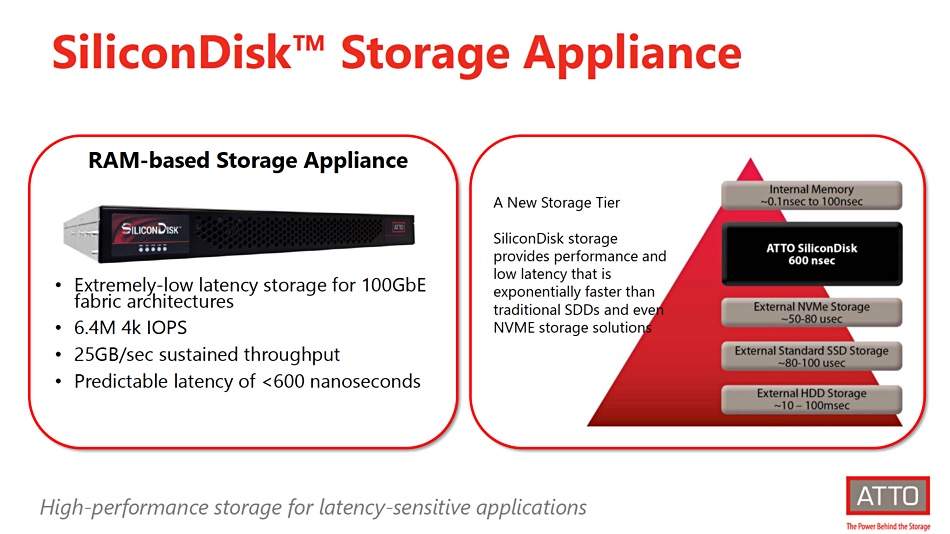ATTO is prepping new generation RAM disk technology in the shape of its SiliconDisk storage appliance. “This is not addressable memory. This is storage. It’s a block storage device,” Peter Donnelly, ATTO Products Group Director, told us.
NY-based ATTO develops high performance storage connectivity products for OEMs and end users. The company’s new SiliconDisk connects to host servers using RDMA across 100Gbit Ethernet, to provide latency at the sub-100 nanosecond level. The appliance is directly attached to servers or shared by several servers across the network, using either direct connections or passing through a switch. It saves data to internal backing NAND if power is lost.

Here are some top-line performance numbers, supplied by ATTO.
- 6,400,000 4k IOPS
- 25GB/sec sustained throughput
- <600ns latency (<0.6μs)
B&F asked Donnelly if ATTO had considered building an Optane-based product. “It was actually one of the options that we considered. And what we found is that the performance wasn’t what we thought it could be. So we actually went down a different path,” he replied. “We actually compare ourselves to the Optane Persistent Memory storage. And we bench better against it.”
We also asked if the SiliconDisk could be used as Nvidia GPUDirect storage and feed data faster to DGX GPU servers? Donnelly said this could be a potential use case “because we are moving data in a RDMA type of environment. So, yes, this could all be pieced together.”
The product is not yet ready and is expected to launch later this year. Pricing was not disclosed.
RAM disk explanation
RAM disks or drives constitute legacy technology. They are DRAM-based and access to data takes place at DRAM speed, many times faster than either SSD or disk drive access speed.
A RAM disk can be a portion of a Windows server’s memory that is set aside to store files that a) need as fast access as possible, and b) where normal caching doesn’t cut the mustard. (SoftPerfect RAM disk is an example.) However, RAM is volatile and the file content is lost when power is switched off or the system crashes.
Another problem is that internal RAM disk capacity is constrained by the amount of the host system’s DRAM and the applications needing to use it. It relies on the availability of spare DRAM. An external RAM disk with a NAND backing store overcomes these problems but introduces another issue – the latency and bandwidth of the network link.
Initially, RAM disks used slow disk drive-based interfaces;
- 2005 – Gigabyte Technology i-RAM 4GB – SATA I interface at 1.5GB/sec.
- 2006 – Gigabyte Technology i-RAM 8GB – SATA II interface. At 3GB/sec
- 2009 – DDRdrive – DDRDrive X1 – 4GB DRAM & 4GB SLC NAND – PCIe Gen 2.0 with x1, x4, x8 or x16 lanes and 25MB/se per lane
The DDRDrive provided 50,000+ 4k random read IOPS (300,000+ 512B random reads) and had a latency around 51μs. Its bandwidth was 215+ MB/sec when writing and 155+ MB/sec reading.
This was not that fast, and take up-was limited. Much faster interfaces and network speeds are available today, giving ATTO the opportunity to reinvent and improve the technology.







